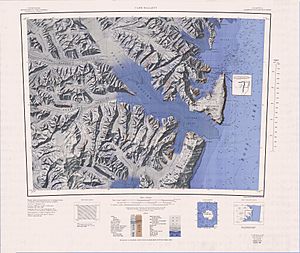Hallett Peninsula facts for kids
The Hallett Peninsula (72°30′S 170°10′E / 72.500°S 170.167°E) is a unique piece of land shaped like a triangle in Antarctica. It's about 20 nautical miles (around 37 kilometers) long. This peninsula has tall cliffs on its eastern side, reaching up to 1,500 meters (almost a mile high!). On its western side, the cliffs are about 300 meters high.
This interesting landform stretches from Cape Hallett to Cape Wheatstone. It's connected to the main continent by a narrow strip of land. This strip lies between the Tucker Glacier and a bay called Edisto Inlet.
Exploring Hallett Peninsula
The Hallett Peninsula is located in a very cold and remote part of the world, Antarctica. It's a significant landmark in the region, known for its dramatic cliffs and unique shape. The peninsula's connection to the mainland by a narrow ridge makes it stand out on maps of the icy continent.
How Hallett Peninsula Got Its Name
The name "Hallett Peninsula" was given by a group of explorers from the New Zealand Geological Survey Antarctic Expedition. This expedition took place in 1957–58. They named it after Hallett Station, which was a research base. Hallett Station was set up on a small piece of land called Seabee Hook, right at the northern tip of the peninsula. So, the peninsula is named after the important station that was once located there.
A Volcano in the Ice!
Did you know that Hallett Peninsula is actually an ancient volcano? It's what scientists call an "elongated shield volcano complex." Imagine a warrior's shield lying on the ground – that's the shape of this type of volcano, wide and gently sloped. It's similar to other volcanic peninsulas nearby, like the Adare Peninsula and the Daniell Peninsula.
The Hallett Peninsula is part of a larger group of volcanoes called the Hallett Volcanic Province. This province is part of an even bigger volcanic area known as the McMurdo Volcanic Group. Scientists have studied the rocks here. They found that the dark, volcanic rock called basaltic lava from the Hallett Peninsula is very old. It formed about 6.4 million years ago! This shows us that this part of Antarctica has a long and fiery geological past.


